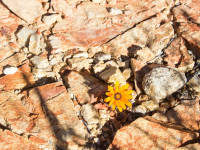Nature's Unifying Patterns
Nature’s Unifying Patterns attempt to identify the ten most essential lessons from the natural world that should be considered as part of a design process. They are called ‘Nature’s Unifying Patterns’ because examples of the patterns can be found broadly across the majority of life on Earth.
Consider these patterns at the start of any design process and return to them throughout the process as an evaluation tool.

Nature uses only the energy it needs and relies on freely available energy.
Life on earth is powered by the sun, as well as residual energy from the earth’s core. Energy is cycled throughout earth’s systems and the optimal amount utilised for nature’s needs.

Nature recycles all materials.
As well as energy, minerals and gases are in continuous cycles within earth’s systems. Some of these cycles occur daily (e.g., respiration), while others occur over millennia (such as the rock cycle). There is no such thing as a waste product.

Nature is resilient to disturbances.
Shocks and disturbances are common on our planet, but nature is remarkably able to respond to upheaval by adapting through strategies developed since the beginning of life on earth.

Nature tends to optimise rather than maximise.
Nature seeks a balance between the required resources for growth, and overdevelopment. Structures are optimised to be efficient and agile.

Nature provides mutual benefits.
Competition in nature occurs when it is impossible to avoid as it is very costly in terms of energy. Nature favours cooperation because it maintains the health of the whole system.

Nature runs on information.
Organisms sense their environment and make use of rapid information to respond. Some organisms can only survive in very particular conditions and heavily rely on environmental information not to stray from these parameters.

Nature uses chemistry and materials that are safe for living beings.
Because chemical reactions are fundamental to cellular processes, it is vital that the raw materials for these processes are not only readily available but also not harmful to the life of the organism. Toxins are also produced but require careful cellular management and degrade rapidly.

Nature builds using abundant resources, incorporating rare resources only sparingly.
Nature builds using abundant resources, incorporating rare resources only sparingly.

Nature is locally attuned and responsive.
The survival of organisms depends on them being able to make use of locally available resources and optimising for the conditions where they live.

Nature uses shape to determine functionality.
Nature makes use of form rather than excess material to increase strength and bolster functionality, thus enabling efficient use of resources.